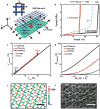Design of Strain-Limiting Substrate Materials for Stretchable and Flexible Electronics
- PMID: 29033714
- PMCID: PMC5639729
- DOI: 10.1002/adfm.201600713
Design of Strain-Limiting Substrate Materials for Stretchable and Flexible Electronics
Abstract
Recently developed classes of electronics for biomedical applications exploit substrates that offer low elastic modulus and high stretchability, to allow intimate, mechanically biocompatible integration with soft biological tissues. A challenge is that such substrates do not generally offer protection of the electronics from high peak strains that can occur upon large-scale deformation, thereby creating a potential for device failure. The results presented here establish a simple route to compliant substrates with strain-limiting mechanics based on approaches that complement those of recently described alternatives. Here, a thin film or mesh of a high modulus material transferred onto a prestrained compliant substrate transforms into wrinkled geometry upon release of the prestrain. The structure formed by this process offers a low elastic modulus at small strain due to the small effective stiffness of the wrinkled film or mesh; it has a high tangent modulus (e.g., >1000 times the elastic modulus) at large strain, as the wrinkles disappear and the film/mesh returns to a flat geometry. This bilinear stress-strain behavior has an extremely sharp transition point, defined by the magnitude of the prestrain. A theoretical model yields analytical expressions for the elastic and tangent moduli and the transition strain of the bilinear stress-strain relation, with quantitative correspondence to finite element analysis and experiments.
Figures



References
-
- Lu NS, Yang SX. Curr Opin Solid St M. 2015;19:149.
-
- Su YW, Wang SD, Huang YA, Luan HW, Dong W, Fan JA, Yang QL, Rogers JA, Huang Y. Small. 2015;3:367. - PubMed
-
- Kim DH, Lu NS, Huang YG, Rogers JA. MRS Bull. 2012;37:226.
-
- Wang C, Hwang D, Yu ZB, Takei K, Park J, Chen T, Ma BW, Javey A. Nat Mater. 2013;12:899. - PubMed
Grants and funding
LinkOut - more resources
Full Text Sources
Other Literature Sources
